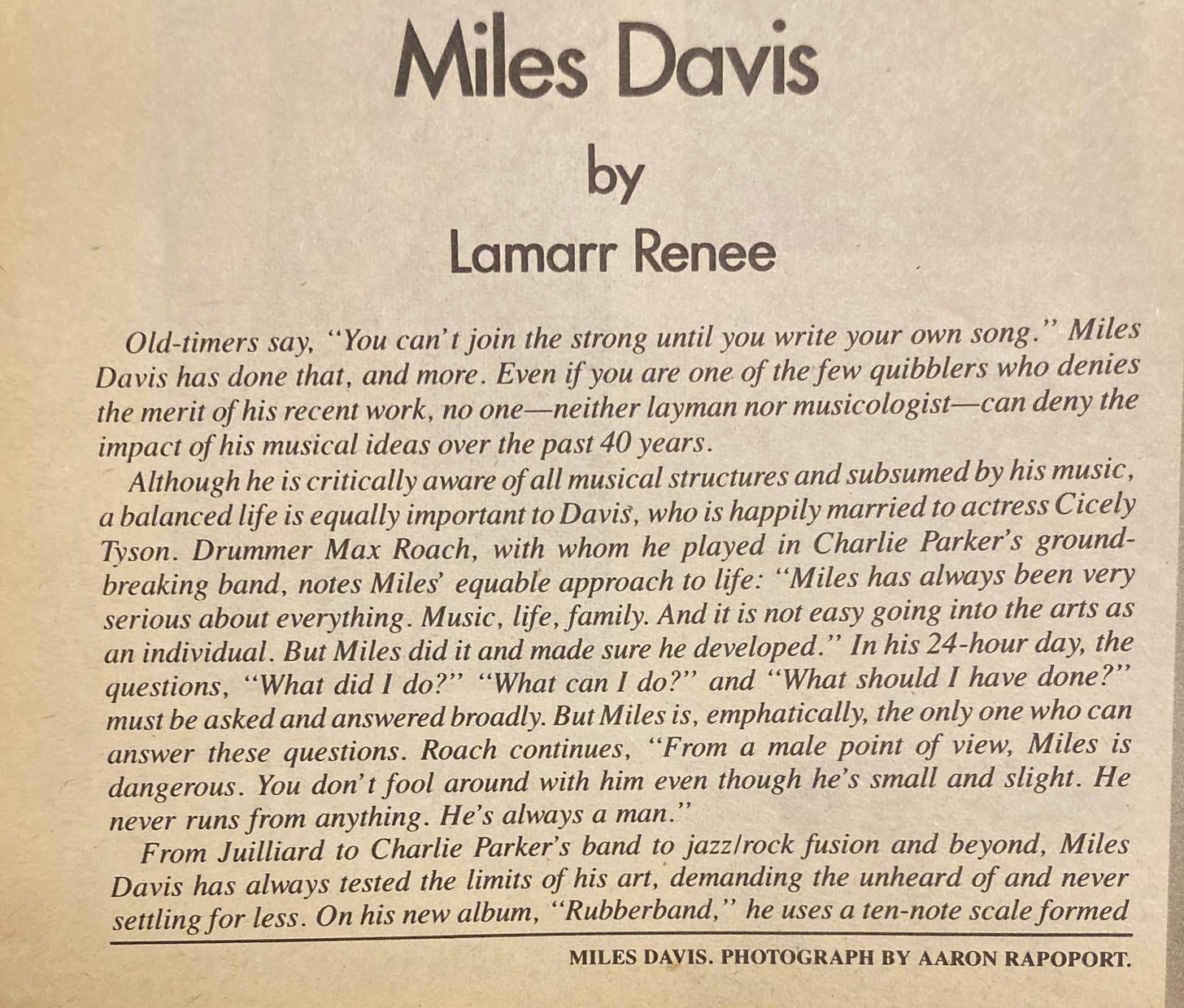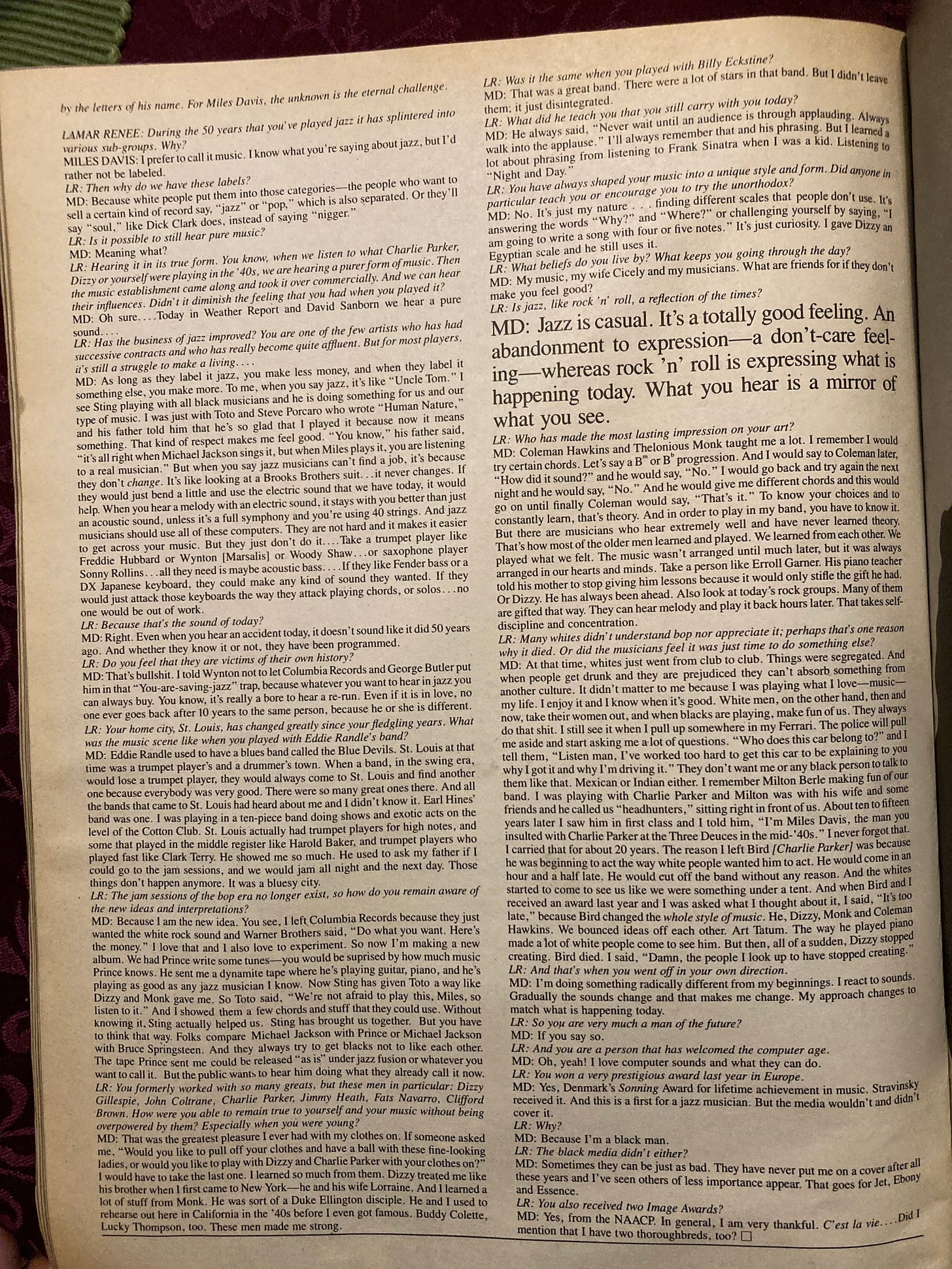(On April 19, 2023, I added more information in the two long paragraphs starting with “For this article” and “At the bottom.”)
(Paying subscribers, there’s a short David Murray article and photo at the bottom for you.)
The April 1986 issue of Andy Warhol’s Interview magazine was dedicated to music. That publication was not known for jazz coverage, and maybe that’s why this interview with Miles seems to be unknown and, I believe, has never been reprinted. There is a preface, and then the interview runs one page. But it’s long, because this magazine had big pages, like a newspaper—11 by 17 inches!—and small print.
The interviewer is LaMarr Renee, a popular evening host on WBLS-FM radio in New York City. When she joined the station in 1972, it was the new flagship station of the Mutual Black Network, and specialized in R&B and Soul recordings. It had replaced WLIB, the jazz station, on which I grew up listening to pianist Billy Taylor’s afternoon program every weekday after school. And WBLS has gone through many further changes since the ‘70s.
Lamarr Renee, a person of many talents, attended Boston University’s School of Public Communication, then worked for an M.A. in Educational Psychology at N.Y.U. Among other interests, she also trained with Lee Strasberg and did some work as an actor, studied French, and taught courses in continuing education.
For this article, Renee also talked with Max Roach, who is quoted on the first page talking about Davis. In the main interview, Miles is very outspoken about racism. He’s in a talkative mood, and gives long answers, addressing everything from his early days to his current plans with Prince. He briefly explains his recent move from Columbia, his long-time record label, to Warner Brothers. But the new album that is mentioned, Rubberband, was held back and did not get released until 2019, eighteen years after Miles’s death. Also, her description belongs to another album: As subscriber and author Johan Hauknes notes, it was the Aura suite, written for Miles by Danish musician Palle Mikkelborg, not a piece by Miles, that is based on the ten letters of Davis’s name. (Aura was recorded early in 1985 but was not released until 1989.)
At the bottom of the first column, Miles is quoted saying that he and Monk used to rehearse in California before Miles was famous. (This was independently pointed out by my former grad student P.J. Cotroneo, and by jazz historian Brian Priestley, in separate emails.) Robin Kelley, in his authoritative Monk biography pp.106-7, notes that Miles hung with Monk in N.Y.C. in the fall of 1945. At the end of 1945, Monk was in L.A. in Coleman Hawkins's, and Miles was there for most of 1946, but I don’t think they were there at the same time. In my opinion, in this quotation, Miles was not talking about Monk—he never “rehearsed” with Monk. He must have been talking about a Los Angeles musician, Buddy Collette or Lucky Thompson or someone in that circle. It appears that Renee misunderstood him. This is a common problem in published interviews, especially when the person being interviewed drops a lot of names.
Davis ends, unexpectedly, by boasting that he owns two “thoroughbreds” (horses bred for racing).
The article included a stunning portrait of Davis by Aaron Rapoport, an accomplished photographer based in Los Angeles. You can see it here—just scroll down a little.
And here is the interview, with Roach quoted first:
I hope you enjoyed that. As always, I’m working on many other posts, in various stages of completion, so I’ll see you again soon.
All the best,
Lewis
P.S. Paying Subscribers, please keep scrolling down.
Keep reading with a 7-day free trial
Subscribe to Playback with Lewis Porter! to keep reading this post and get 7 days of free access to the full post archives.




